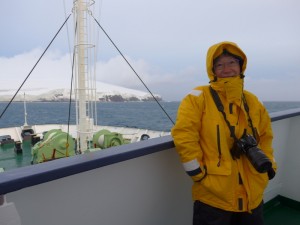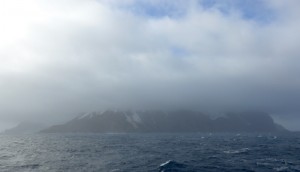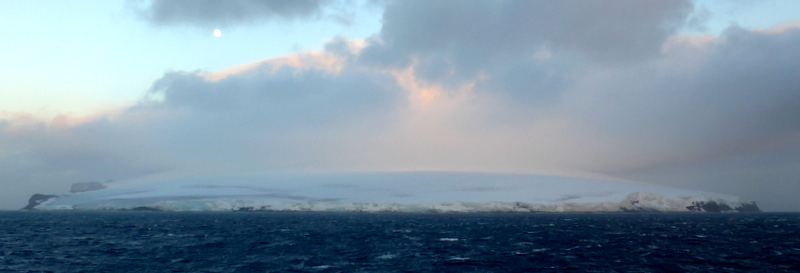Day 14 – 19 ( April 6 – 11, 2015): Bouvetøya
Day 14 (April 6, Monday): Bouvetøya – Noon GPS position 54° 24’ S / 003° 31’ E; Weather +2°C, overcast, some sun, wind variable courses/speeds
The ‘Judgment Day’ has finally come! At 6:30am, Jan’s voice comes over the PA system urging us to go outside to watch sunrise. The ship is sailing towards the southern (leeward) side of Bouvetøya. But the wind is still blowing over 50-70 knots.
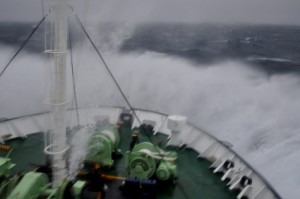 |
Anxiety runs high: we have good visibility and reasonably bright light, but very strong, gusting winds. The foam-whipped ocean is quite a sight as the ship ploughs through the crests and troughs of the waves while manoeuvring at a safe distance from the island. Both Jan and the Captain see no possibility for landing today – I trust their judgment. Instead, we circumnavigate the island for over five hours, looking at it at all possible angles.
In the original itinerary, two days (Days 13-14) are kept for a landing as it is always difficult if not impossible to make a safe landing. Hence the question is whether to stay on for one more day or move on. Given the weather forecast, it is not hopeful for a landing the following day owing to the treacherous swells. Jan and the Captain have sent their assessment to Oceanwide Expeditions headquarters in the Netherlands and await instructions on whether to wait one more day or depart immediately for Gough Island, our next destination.
Opinions as expected are split. Most ‘non – travel club’ passengers see no point in wasting time and want to move on. ‘Travel Club’ passengers think otherwise and feel two days should be allocated as indicated in the itinerary.
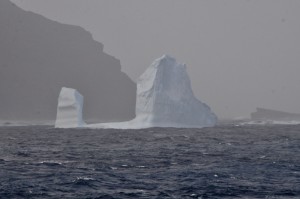 |
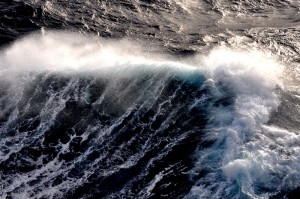 |
 |
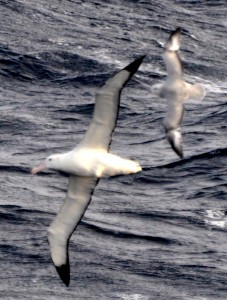 |
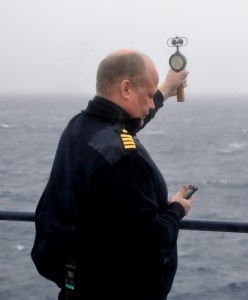 |
Ortelius is drifting north while awaiting a decision. We have lunch and watch a documentary on fur seals. Then we are called to go to the bar for our third update of the day. Jan informs us that the ship will head back to Bouvetøya at 10pm tonight and we shall see whether a landing is possible the following day. Some passengers are relieved and delighted while others consider it a waste of time. Jan handles the situation well with clear explanations on Oceanwide’s consideration and decision while showing understandings of conflicting demands from passengers. Anyway, the waiting game is not over. Will we land at Bouvetøya tomorrow?
I have my first afternoon nap after knowing we go nowhere but return to Bouvetøya. At the 6:30pm recap, Jan goes through the weather chart again reassuring us that we would only be losing a day. Adam then talks about the complex geology around Bouvetøya where three tectonic plates meet in this part of the ocean. Victoria tells us about the problems of calculating longitude without GPS or a reliable clock before the Greenwich Meridian coming into existence.
In the evening, I watch a romantic film ‘One Hundred Foot Journey‘ about an Indian young man who is passionate about cooking and his path to fame as a Michelin star chef. A fairy tale story! (L-fried chicken; D-fish) 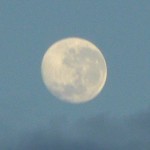
Day 15 (April 7, Tuesday): Bouvetøya & Sail North – Noon GPS position 54° 03’ S / 003° 02’ E; Weather +3°C, overcast, some sun; Wind W6; Sea 5; 1 lecture; 1000nm to Gough Island
I must be exhausted: I sleep without problem till 6am. The sea is calmer without whitecaps and we have clearer views of the island with gleaming slopes of snow and ice. The winds are still blowing at 40-60 knots with swells. The ships sails along the southern and later western side of the island assessing the possibility of making a safe landing. 
I can see the strong surf crashing up the narrow beaches that are overhung by glaciers with my naked untrained eyes. There is also a notable amount of ice debris churning around in the breakers. At 9 am the Captain and Jan conclude that a safe landing is impossible and the swell is unlikely to ameliorate in the next few hours. They decide it is time to leave Bouvetøya and begin our 1000nm-journey northwards to Gough Island in the Tristan da Cunha archipelago.
We have circumnavigated Bouvetøya fully and I stay on deck for hours staring at Bouvetøya before it disappears from sight. I must have looked at it for some ten hours from all sides: I am content and would say I have been to have been to Bouvetøya (though some people disagree).
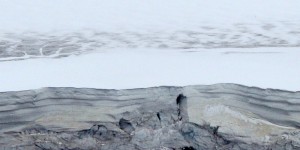 |
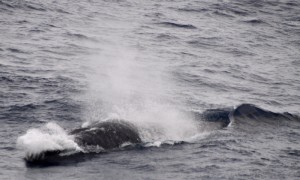 |
 |
 |
What is magical about Bouvetøya? Nature, landscape and wildlife? Mineral resources and potentials? Or its sheer remoteness, exclusiveness and inaccessibility? I must have caught the ‘insane’ flu: I lose my balance slightly when stepping from the deck into the bridge and hit my camera on a steel-framed monitor. The filter breaks: bad luck but fortunately the lens is not damaged.
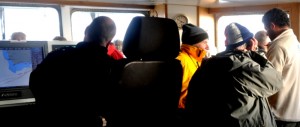 |
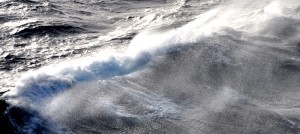 |
What is magical about Bouvetøya? Nature, landscape and wildlife? Mineral resources and potentials? Or its sheer remoteness, exclusiveness and inaccessibility? I must have caught the ‘insane’ flu: I lose my balance slightly when stepping from the deck into the bridge and hit my camera on a steel-framed monitor. The filter breaks: bad luck but fortunately the lens is not damaged.
In the afternoon, we see Fur seals, Fin and Sei whales, and enormous flocks of Southern fulmars, prions, Black-bellied storm petrels, and even the occasional Wandering and Light-mantled sooty albatross.
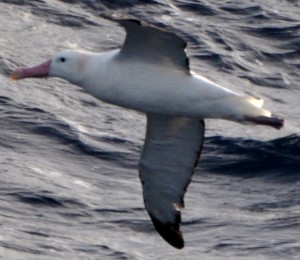 |
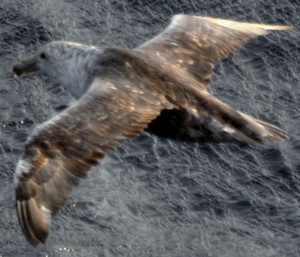 |
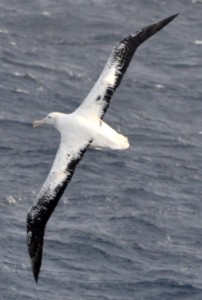 |
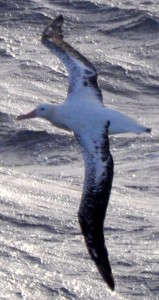 |
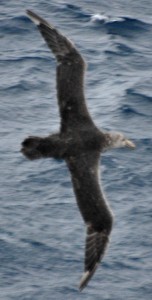 |
We expect 4-5 full sea days before arriving at Gough Island. Hence, the expedition team chooses a four-part geological documentary series called ‘Rise of the Continents‘ for screening. Today, I watch part I which focuses on North & South America.
Then Victoria tells us about the history and diamond-hunting tales about Gough Island – that outlier of Tristan da Cunha, some 400 km SSE of the main archipelago. In the evening I watch a wonderful sunset over a reasonably calm sea, although that same old swell keeps rolling our ship through the night. The evening movie ‘ Imitation Game‘ about Alan Touring, father of computer is good. He broke into the code used by the Nazi during WWII and his achievement was kept as a secret for over 50 years. (L-hamburger, D-fish)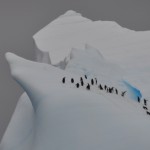
Day 16 (April 8, Wednesday): At sea – Noon GPS position: 50° 48’ S / 000° 22’ W; Weather +5°C, overcast; Wind NE6; Sea 5; 2 lectures
Today, we have poor weather with rain and waves reaching 9-12m and creating big sprays – situation normal for the South Atlantic Ocean. I feel tired and suddenly fancy some comfort food for breakfast. Hence, I ask the restaurant staff to cook noodles I have brought with me. I enjoy my delicious noodle with soya sauce and olive oil and feel much better.
 |
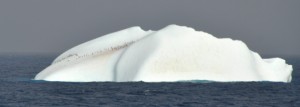 |
In the morning Christian gives a very good talk ‘Seabirds en route to Tristan da Cunha’. He shows us photos of different species of petrels and albatrosses.
In the afternoon, I watch part 2 of ‘Rise of the Continents’ on the creation of Africa before attending Victoria’s lecture on Gough Island, a small island (13 x 7 km) located at 40° S/10° E belonging to the archipelago of Trsitan de Cunha which is part of the British Overseas Territory. Discovered by Portuguese navigator, Gonçalo Alvarez probably in July 1505, the island is now a World Heritage Site. No visitor is allowed to step on the island which has cliffs ranging from 500 to 1,000 ft high and no sheltered bay or harbour. We can if weather permits, have a zodiac or ship cruise.
Before the recap, Harry Mitsidis, a passenger on the ship gives a presentation entitled ‘The Best Travelled Club & UN Travellers Hall of Fame’ – outlining the activities and internet site of the club. There are 1281 regions/places to visit on TBT’s list: one has to show proof of his/her visit. I admire the dedication and amount of time Harry and Thomas (another passenger) devote to their club. We all receive a free calendar!
At the recap Jan breaks the bad news about a bronchitis epidemic in Tristan de Cunha which has an area of 184km² and a population of 300. As half of the population has been infected, no one is allowed to land or leave the island. The Captain and Jan (together with the Oceanwide Expeditions office) are working out landing opportunities as travel club members need to step ashore before ticking the place off the list. There is nothing one can do with an epidemic: we just have to be patient and hope for the best.
Tonight, I enjoy watching ‘ Phenomena‘ – an award-winning film based on true events happening to a young Irish unwed mother whose boy was taken away from her. With the assistance of a journalist, she went to Washington DC only to find that her son died eight years ago of AIDS and was buried according to his wish, in the place where he was born! A touching story!
Dreadful winds and swells make the ship rocking from side to side with horrible loud noises. I get up around 2am. As the bridge is closed, I stay at the empty bar till 5am. Another sleepless night! (L-pasta; D- roast beef)
Day 17 (April 9, Thursday): At sea – Noon GPS position 48° 40’ S / 001° 29’ W; Weather +6°C, overcast, some sun; Wind WSW6; Sea 5; 2 lectures
I finally manage to sleep at 6:30am and skip breakfast. It’s a bright day and I get outside for fresh air. As a reward, I see Gough albatrosses flying around our ship. They are more aptly named ‘Atlantic Wandering albatross’, of which fewer than 10,000 individuals survive the threats of longline fishing and oversized mice at the colonies. Mice that prey on the chicks, affect dramatically (90% down), the breeding success of the annual cohort of 2,000 couples (these albatrosses breed every other year, sometimes every three or four years even).
I feel better after spending some time on deck. Adam’s well-structured talk on ‘The Life and death of Volcanic Islands’ is interesting and informative. Dramatic forces from the earth’s mantle, such as the product of subduction of continental plates and hotspots have created the islands we have visited and shall soon be visiting. Part 3 of ‘Rise of the Continents’ also tells me about howEurasia was born. Fascinating!
Victoria’s lecture on ‘A History of Tristan da Cunha: discovery, settlement and shipwreck’ is timely and informative. The islands located at 37°6′44″S/ 12°16′56″W were first discovered by Portuguese admiral Tristão da Cunha when trying to find a sailing route to the Far East: Gough in 1505 and Tristan da Cunha in 1506. The group is 2,000 km from St Helena, 2,400 km from South Africa and 3,360 km from South America.
The first recorded landing was 1643. Despite plentiful water, fish, seals, and seabirds, the islands remained uninhabited because they lack safe anchorages. The first attempt to settle the islands was led by Jonathan Lambert, (a Yankee whaler), Thomas Corri and Williams in 1810 but only Corrie remained there as a farmer. In 1816, Britain annexed the islands. When British withdrew the military, Corporal William Glass, with a few others, chose to stay behind to form a settlement.
Many events particularly ship wrecks have affected the fortune of the island and sometimes brought new members to the island. Then American prisoners arrived in 1864, the Suez Canal opened in 1869, and the island became formally a British Dependency in 1875.
The current population of about 300 is thought to have descended from 15 ancestors (8 males and 7 females) who arrived between 1816 and 1908. There are some 80 families living on Tristan da Cunha sharing only eight surnames.
I find this small community unique and admirable. In 1817 William Glass founded the settlement based on equality: all families are farmers and all land is communally owned with each family having a plot of land at the Patches where they grow potatoes. They have cattle and sheep and the community has earnings from commercial crawfish and issuing stamps and coins. The revenue is used of providing communal services and facilities.
At the recap, we learn about the weather forecast, the epidemic situation in Tristan and progress of our sister ship, Plancius which is just ahead of us. After dinner, I watch ‘The Theory for Everything‘ which is about the life of Stephen Hawking, a world renowned theoretical physicist, cosmologist and author who has suffered from a rare form of motor neuron disease. A good film. (L: lamb curry; D-pork neck and fish)
Day 18 (April 10, Friday): At sea – Noon 12:00 GPS position 45° 33’ S / 004° 59’ W; Weather +10°C, overcast; Wind NNE7; Sea 6; 2 lectures
It is getting warmer and warmer. Today, I learn more about how to distinguish a Wandering albatross from a Royal Southern albatross after Christian’s lecture. He also shows us photos of Soft-plumaged, Kerguelen and Atlantic petrels, Tristan and Black-browed albatrosses and Great shearwater (one of only a few bird species to migrate from breeding grounds in the Southern Hemisphere to the Northern Hemisphere).
The last part of ‘Rise of the Continents’ on Australia is fascinating. It has broken away from Africa and Antarctic to become a continent on its own. But now it is moving slowly towards India and Asia and may be part of Asia in 40 million years’ time. Then Bob talks about whales again. I should know a lot about whales by now. Unfortunately, I am lazy and do not take notes. Soon, I shall forget all I have learnt.
There is no further news about the situation in Tristan da Cunha. But it is clear that there is no prospect for landing. Jan is exploring possible landing on uninhabited islands. Alan brings our recap to a highlight when he sings us a self-written song about our cruise and its tantalising destinations. He is an adorable Dane!
I watch ‘St Vincent‘, a funny story about a boy and his baby-sitter. The swells, frequent rock and roll movements and noises keep me awake again. Another sleepless night! (L-fish & chip; D-chicken skew)
Day 19 (April 11, Saturday): At sea – Noon GPS position 42° 35’ S / 007° 58’ W; Weather +13°C, sunshine; Wind W7; Sea 6; 1 lecture
Sleep deprivation makes me tired. I manage to have two hours’ sleep before breakfast. The weather changes all the time. When the winds are blowing hard with swells building up, the ship has to slow down. Hence we lose a day on this stretch.
After breakfast, Brent sells us baseball caps from Tristan da Cunha (US$25 each). He has been commissioned to restock the Tristan souvenir shop and is bringing a stock of caps in his luggage. The caps, proceeds from sales together with medicines that are in short supply on the island will be sent ashore. I seldom buy souvenirs. But I get one as a small contribution to the island which I shall never land.
Many of us watch a wonderful BBC documentary on ‘Captain Cook – the Man behind the Legend‘. A genius explorer, Cook circumnavigated the Antarctica, discovered NZ and Australia and mapped the coastline of Canada, NZ, eastern part of Australia and parts of the Antarctic. After two very successful voyages, he embarked on his third and last one expedition in search of a Northwest passage when he was killed by natives of Hawaii in 1779.
In the afternoon, I watch Parts 1 & 2 of ‘The Secrets of Bones‘ with amazement. Bone is such a unique substance being both flexible and strong and we can learn so much about animals from their skeletons.
The ship is getting a bit friskier at around 4.30 pm. Nonetheless, many passengers still stay quietly in the windowless lecture room to listen to Victoria’s talk on the island’s social history of the 20th century. This isolated island has witnessed big changes as a result of increasing influence from the ‘houtside warl’ (outside world), especially during World War II and the ‘Volcano Years’ (1961 – 63) when the entire community was evacuated to Britain. After returning home, the Tristan islanders had to find a way to merge their former life-style of freedom and anarchy into a way of life that could also embrace the cash economy of the modern world – if they were to retain their independence. They have, in the last 50 years, succeeded in finding a surprisingly successful compromise, whereby they can retain the best elements from their former subsistence life-style, yet live a 21st century life too, though isolated from the rest of the world. David Smallman has so aptly said: “Physically, the island is their universe, but mentally, it isn’t any more”.
The recap is well-attended as we are all anxious to learn about the plan for Gough Island. We are envious of Plancius which has not been delayed by winds and swells and her passengers had a zodiac cruise at Gough island today. Our ship due to delay by strong winds and swells might not arrive at the island till sometime tomorrow. Owing to limited time available, we might not have a zodiac cruise. Some frustrated passengers are upset and one says aloud that ‘the trip is ruined’. Jan gently reminds us that we had good weather and landings at the beginning of the journey: he has tried his best to make these unhappy souls understand this is an expedition and we are at the mercy of Mother Nature. His team hopes to arrange more landings wherever weather permits. Adam shows us some photos illustrating Gough’s unique geology.
Tonight’s movie is a comedy/drama set in Paris – ‘An Old Lady’. I enjoy it as I like Paris and Maggie Smith who takes on the role of the heroine. (L-chicken & rice; D-seafood chowder)


